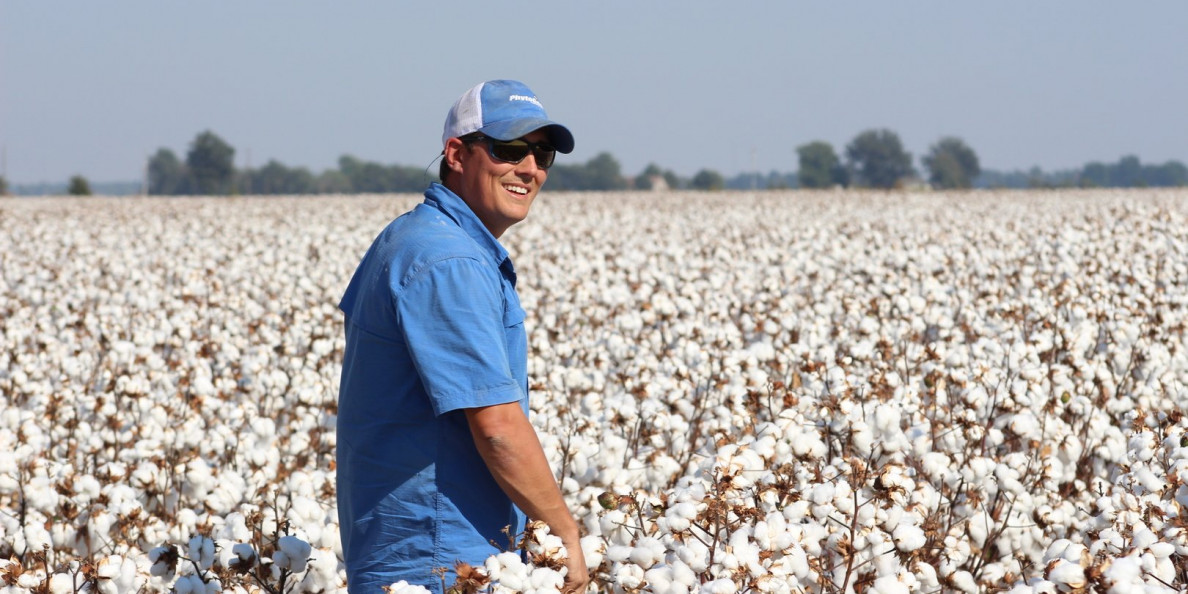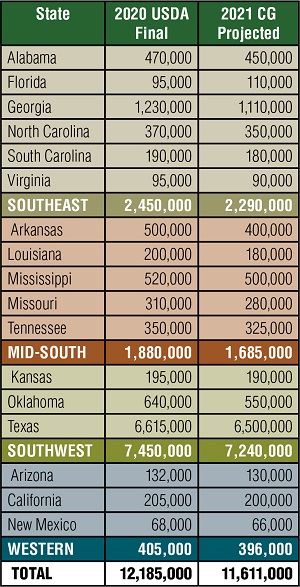By Jim Steadman
Following a year of marginal prices, difficult planting conditions, hurricanes, drought and the overall social and economic malaise brought about by COVID-19, you couldn’t blame cotton growers for questioning their prospects for 2021. A bump in cotton prices back into the low 70 cent range at the end of the year eased some of the concerns. But equally rising prices for corn, soybeans, wheat and other grain crops are certainly making cropping decisions tough for the coming season.
That said, any predictions for 2021 cotton acreage at this point in time is still anyone’s best guess. But we still wanted to give it our best shot.
Based on the results of the Cotton Grower Acreage Survey recently conducted with cotton growers and other industry sources, U.S. cotton producers appear set to plant 11,611,000 acres of cotton – upland and ELS combined – in 2021. That’s roughly a 4.7% decrease from the 12,185,000 planted acres reported by USDA-NASS last June.
Certainly commodity prices will have a definite influence in acreage decisions. But for cotton, growers also have to contend with decreased global demand for cotton products driven by COVID-19, dialed down mill capacities, uncomfortably high cotton carryover stocks for the U.S. and the world, and continued export competition with Brazil and India.
Then there’s China. To their credit, China continued to import healthy amounts of U.S. cotton during 2020, partly to meet the obligations of the Phase I Trade Agreement but also to ensure adequate supplies of cotton for the country’s mills that aren’t sourced from the country’s Xinjiang region. Long standing rumors of forced labor practices in the region resulted in the U.S. blocking all cotton-related imports from Xinjiang in early December. How this decision will impact cotton trade with China in 2021 remains to be seen.
And in an industry that’s already weather-weary, 2021 promises to be a La Niña year, which traditionally means hotter, dryer weather for areas of the Southwest that are still trying to recover from intense drought in 2020.
That’s a lot to consider for this year’s cropping decisions. But as our survey results show year after year, cotton growers tend to grow what they know best – more cotton.
Let’s look at what respondents told us on a regional basis.
Southeast
In the Southeast, Georgia will continue to lead the way with a projected 1,110,000 acres. Overall, growers in Alabama, Florida, Georgia, the Carolinas and Virginia tell us they’ll plant 2,290,000 acres of cotton – with only Florida indicating a slight acreage increase.
“Harvested acreage in 2020 will be down due to the damage from several hurricanes and tropical storms,” reports David Wright of the University of Florida. “But prices will increase acreage slightly for 2021.”
Mid-South
In the Mid-South, the survey projects 1,685,000 acres between Arkansas, Louisiana, Mississippi, the Missouri Bootheel and Tennessee. Mississippi will still lead the way with 500,000 projected acres, but overall, all states should see decreases.
“I heard that producers with gins that pay a good rebate were still thinking about being down 10% for next year considering the current prices of everything,” says Bill Robertson, University of Arkansas Extension cotton specialist. “Gins with not as good rebates could see a bigger drop even with picker payments.
“Economists are thinking the rally on competing commodities has not finished,” he adds. “We could be down 20 to 25% if corn and bean prices continue to improve. I’m guessing right now I would have to go with 20% down in 2021 with the market forecast and hope it’s not the 30% I have heard from some.”
Other commodity prices also influence Tyson Raper’s thinking.
Raper, University of Tennessee Extension cotton specialist, admits, “This is a shot in the dark, because things are very fluid at the moment. We should be down slightly from our 2020 acres. Grain prices during September hampered interest in increasing Tennessee cotton acreage for 2021, but some of that hesitation has subsided with more recent market shifts.”
Southwest
As always, the Southwest region will lead the way in overall production acreage, thanks to that large West Texas cotton patch. And although total acres are projected to be down somewhat, growers in Kansas, Oklahoma and Texas will combine to plant 7,240,000 acres of cotton, based on the survey. Texas growers indicate plantings of 6,500,000 acres – not quite a 2% decrease from 2020.
“Dryness is going to influence Texas plantings,” points out Dr. John Robinson, professor and Extension specialist/cotton marketing at Texas A&M University. “If you look at the drought monitor and draw a line from the eastern edge of the Panhandle down, everything west of that is in exceptional drought right now. And La Niña is supposed to continue through May, right through planting time. The typical Texas farmer response to that is – even with an insurance price of 74 cents – we just don’t have the alternative crops here. So agronomically speaking, you’re better off planting cotton. And from an insurance standpoint, you’re better off planting cotton.
“I wouldn’t be surprised if we had 6 million acres at all,” he adds. “And if we had 7 million acres, I wouldn’t be surprised to see that either – planted with the expectation of 50% abandonment.”
Oklahoma State Extension Cotton Specialist Seth Byrd also expects a drop in acreage in his area.
“I think we’ll see at least a slight dip in acreage,” he says. “Many folks who may have made the move to cotton more recently will probably put at least a portion of those acres back into soybeans or sorghum due to the markets. I do think many of those producers have gained a greater comfort level with cotton, and it may become part of a rotation for many who have tried it out for the first time in the last 3 to 4 years.
“However, Oklahoma still has a lot of folks who view themselves as primarily cotton producers, and many in this category have also increased acreage during recent years as well,” he notes. “That’s where we’ll see some of the stability for this new acreage level compared to where the state was 7 or 8 years ago. There are large areas of the state, particularly in the southwest and west-central areas, where cotton is still likely to be the most popular and successful choice.”
Western
In the Western states – where a high percentage of acres are generally reserved for seed production – Arizona, California and New Mexico all show slight decreases for a combined projected total of 396,000 upland and ELS cotton acres. California will continue to lead overall regional plantings with 200,000 projected acres.
Snapshot in Time
The Cotton Grower survey was conducted in November and early December, with responses coming to us from growers, ginners, consultants and other affiliated industry sources. Other acreage projections will be coming in February from the National Cotton Council and in March from USDA-NASS, and we look forward to comparing our results with theirs. All of them – like the Cotton Grower survey – reflect a snapshot of the market situation and prevailing attitudes and thinking at the time of the survey.
Here’s to a successful and productive 2021!



